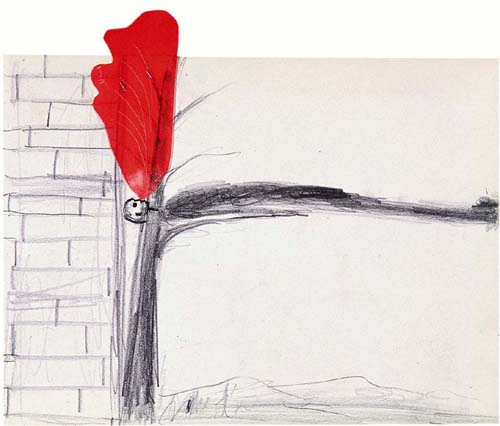18/9/2002
Enzo Cucchi 1979-2001
Artium, Vitoria-Gasteiz
works on paper

ARTIUM PRESENTS ENZO CUCCHI. DRAWINGS, 1979-2001
This is the first review of the works on paper of this Italian artist
ARTIUM, Basque Centre-Museum of Contemporary Art, presents a major retrospective exhibition of the Italian artist, Enzo Cucchi. This is the first time that a representative selection of the drawings, which constitute such an important part of his oeuvre, has been offered in Spain. Enzo Cucchi. Drawings 1979-2001 is a painstaking collection of works created during the last quarter of the twentieth century and offers spectators the opportunity to gain an insight into Cucchi's work in this medium. The show has been organised and produced by ARTIUM, with the collaboration of the Bruno Bischofberger Gallery of Zurich, and consists of a total of 144 works on paper. This exhibition will remain open in the Lower East Gallery until November 10.
Born in 1949 near Ancona, Italy, Cucchi's oeuvre shows a clear predominance of drawings and paintings, characterised by an element of fantasy and a surprising narrative capacity. At the end of the nineteen seventies he moved to Rome where, provisionally, he took a break from writing poetry in order to dedicate himself almost exclusively to the visual arts.
There, Cucchi came into contact with artists such as Francesco Clemente and Sandro Chia, with whom he began a fertile dialectic and intellectual exchange. Together with them, Cucchi is considered to be one of the main representatives of the Transvanguardia, an Italian artistic movement that emerged at the beginning of the nineteen eighties and which, after a number of years characterised by the formal and conceptual experimentation of the so-called "new artistic behaviours", involved a return to figurative painting.
For the first time in Spain, Enzo Cucchi. Drawings 1979-2001 offers an extensive selection of drawings by the Italian artist Enzo Cucchi and illustrates his development in this medium. Since he embarked on his artistic career, Cucchi's drawings have occupied a prominent place in his creative process. The show contains works dating from the end of the nineteen seventies to the present day and allow spectators not only to gain an insight into the genius of his personal universe, but also offers them the opportunity to take a fresh look at his work in this media. In spite of being one of the major figures on the creative scene of recent decades, his work has been the subject of only two previous exhibitions in Spain. The first of these was in 1985 at the Fundación Caja de Pensiones, and the second in 1991 in Barcelona, at the Fundación Joan Miró.
The soul of the artistic development
As Luca Marenzi indicates in the text that accompanies the exhibition catalogue, "drawing forms an integral part of the artistic activity of Enzo Cucchi. It is the heart of his artistic development. It is also a discipline in which he has obtained great distinction". Marenzi adds that "irrespective of the historical and radical importance of his work on paper, his capacity as a creator of images and as a draughtsman, in the classical sense, is impressive. Of his generation, perhaps George Condo, with his unbridled talent, is the only artist who reached a similar level of intensity with regard to a technical capacity for drawing".
For Cucchi, drawing and painting represent a means of associating shapes, concepts and materials. The expression of a gesture is used to transform the paper or canvas into a magical territory full of images and thoughts, vehicles of a discourse that is broken up into an endless number of elements. Cucchi presents a wide range of different symbols of a classical or dreamlike nature, taken from the present or from recollections, which are combined and superimposed on the chromatic texture from which, at the same time, they seem to emerge. The abandonment of space-time coordinates and his continual incursions into cultural and emotional territories coincide with his undisciplined use of colour and his eagerness to experiment with different artistic techniques, from burnt paper to oil and sand.
The key to the drawings of Cucchi is in his special way of filling spaces. Frequently, the edges are not marked. The lines he draws are important but much less so than the effect of depth and mass he is capable of creating with little more than a pencil or ball-point pen. The depth he creates allows one to see what is happening half a metre underneath the paper. Hence, his interest in the archaeological strata to which these drawings are often linked. Cucchi's drawings deal with the deep dimension of images, not what is on the surface. They do not allude to a representation of three-dimensional space, but delve into the nature of things. Because, in short, for Cucchi, "the idea of a drawing is the only opportunity for man to think".
ENZO CUCCHI. Drawings 1979-2001
ARTIUM of Ãlava. Lower east Gallery. September 19 to November 10
Project Manager: Juan Guardiola
Catalogue texts: Luca Marenzi and Javier González de Durana
Produced by ARTIUM. With the collaboration of the Bruno Bischofberger Gallery of Zúrich, Switzerland
ARTIUM
Arte Garaikideko Euskal Zentro-Museoa - Centro-Museo Vasco de Arte Contemporáneo
Francia, 24, 01002 Vitoria-Gasteiz
Tf 34.945-209000. Fax. 34.945-209049



